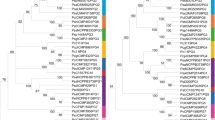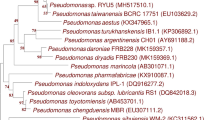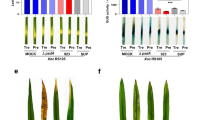Abstract
The leaf surface harbors a host of bacterial epiphytes that are capable of influencing the quorum sensing (QS) system of the plant pathogen Pseudomonas syringae pv. syringae (Pss). Pss uses QS to regulate expression of genes conferring extracellular polysaccharide production, motility and factors contributing to virulence to plants. About 7% of bacterial epiphytes isolated in this study produce the Pss cognate signal, 3-oxohexanoyl-homoserine lactone (3OC6HSL), often in amounts more than 10-fold higher than Pss. Premature induction of QS in Pss by these 3OC6HSL-producing epiphytes suppressed swarming motility and subsequent disease of the leaf. Co-inoculation of 3OC6HSL-producing strains with Pss reduced the number of lesions when inoculated together onto leaves compared with that of plants inoculated with Pss alone. Strains in which 3OC6HSL accumulation was quenched by expression of an N-acyl-homoserine lactonase did not decrease disease when co-inoculated with Pss. Disease incidence caused by a nonmotile mutant of Pss was not affected by 3OC6HSL-producing bacteria, suggesting that exogenous 3OC6HSL signal that altered the motility of Pss was responsible for reducing the apparent virulence of this pathogen. Thus, considerable cross talk involving exogenous 3OC6HSL occurs on leaves and this process can be exploited for disease control.
Similar content being viewed by others
Log in or create a free account to read this content
Gain free access to this article, as well as selected content from this journal and more on nature.com
or
References
Altschul SF, Madden TL, Schaffer AA, Zhang JH, Zhang Z, Miller W et al. (1997). Gapped BLAST and PSI-BLAST: a new generation of protein database search programs. Nucleic Acids Res 25: 3389–3402.
Bauer WD, Robinson JB . (2002). Disruption of bacterial quorum sensing by other organisms. Curr Opin Biotechnol 13: 234–237.
Cha C, Gao P, Chen YC, Shaw PD, Farrand SK . (1998). Production of acyl-homoserine lactone quorum-sensing signals by Gram-negative plant-associated bacteria. Mol Plant Microbe Interact 11: 1119–1129.
Dong YH, Xu JL, Li XZ, Zhang LH . (2000). AiiA, an enzyme that inactivates the acylhomoserine lactone quorum-sensing signal and attenuates the virulence of Erwinia carotovora. Proc Natl Acad Sci USA 97: 3526–3531.
Dulla G, Lindow SE . (2008). Quorum size of Pseudomonas syringae is small and dictated by water availability on the leaf surface. Proc Natl Acad Sci USA 105: 3082–3087.
Dulla G, Marco M, Quinones B, Lindow S . (2005). A closer look at Pseudomonas syringae as a leaf colonist—the pathogen P. syringae thrives on healthy plants by employing quorum sensing, virulence factors, and other traits. ASM News 71: 469–475.
Fray RG, Throup JP, Wallace A, Daykin M, Williams P, Stewart GSAB et al. (1999). Plants genetically modified to produce N-acylhomoserine lactones communicate with bacteria. Nat Biotechnol 17: 1017–1020.
Gantner S, Schmid M, Durr C, Schuhegger R, Steidle A, Hutzler P et al. (2006). In situ quantitation of the spatial scale of calling distances and population density-independent N-acylhomoserine lactone-mediated communication by rhizobacteria colonized on plant roots. FEMS Microbiol Ecol 56: 188–194.
Givskov M, DeNys R, Manefield M, Gram L, Maximilien R, Eberl L et al. (1996). Eukaryotic interference with homoserine lactone-mediated prokaryotic signaling. J Bacteriol 178: 6618–6622.
Gonzalez JE, Marketon MM . (2003). Quorum sensing in nitrogen-fixing rhizobia. Microbiol Mol Biol Rev 67: 574–592.
Haefele DM, Lindow SE . (1983). The influence of motility on epiphytic survival and ice nucleus production by Pseudomonas syringae. Phytopathology 73: 808.
Haefele DM, Lindow SE . (1987). Flagellar motility confers epiphytic fitness advantages upon Pseudomonas syringae. Appl Environ Microbiol 53: 2528–2533.
Hirano SS, Upper CD . (2000). Bacteria in the leaf ecosystem with emphasis on Pseudomonas syringae—a pathogen, ice nucleus, and epiphyte. Microbiol Mol Biol Rev 64: 624–653.
Huang JJ, Han JI, Zhang LH, Leadbetter JR . (2003). Utilization of acyl-homoserine lactone quorum signals for growth by a soil pseudomonad and Pseudomonas aeruginosa PAO1. Appl Environ Microbiol 69: 5941–5949.
Joyner DC, Lindow SE . (2000). Heterogeneity of iron bioavailability on plants assessed with a whole-cell GFP-based bacterial biosensor. Microbiology (UK) 146: 2435–2445.
King EO, Ward MK, Rainey DE . (1954). Two simple media for the demonstration of pyocyanin and fluorescein. J Lab Clin Med 44: 301–307.
Kinscherf TG, Willis DK . (1999). Swarming by Pseudomonas syringae B728a requires gacS (lemA) and gacA but not the acyl-homoserine lactone biosynthetic gene ahlI. J Bacteriol 181: 4133–4136.
Lin YH, Xu JL, Hu JY, Wang LH, Ong SL, Leadbetter JR et al. (2003). Acyl-homoserine lactone acylase from Ralstonia strain XJ12B represents a novel and potent class of quorum-quenching enzymes. Mol Microbiol 47: 849–860.
Loh J, Pierson EA, Pierson III LS, Stacey G, Chatterjee A . (2002). Quorum sensing in plant-associated bacteria. Curr Opin Plant Biol 5: 285–290.
Loper JE, Lindow SE . (1987). Lack of evidence for in situ fluorescent pigment production by Pseudomonas syringae pv syringae on bean leaf surfaces. Phytopathology 77: 1449–1454.
Marco ML, Legac J, Lindow SE . (2005). Pseudomonas syringae genes induced during colonization of leaf surfaces. Environ Microbiol 7: 1379–1391.
Mathesius U, Mulders S, Gao M, Teplitski M, Caetano-Anolles G, Rolfe BG et al. (2003). Extensive and specific responses of a eukaryote to bacterial quorum-sensing signals. Proc Natl Acad Sci USA 100: 1444–1449.
Miller MB, Bassler BL . (2001). Quorum sensing in bacteria. Annu Rev Microbiol 55: 165–199.
Monier JM, Lindow SE . (2003). Differential survival of solitary and aggregated bacterial cells promotes aggregate formation on leaf surfaces. Proc Natl Acad Sci USA 100: 15977–15982.
Monier JM, Lindow SE . (2004). Frequency, size, and localization of bacterial aggregates on bean leaf surfaces. Appl Environ Microbiol 70: 346–355.
Monier JM, Lindow SE . (2005). Spatial organization of dual-species bacterial aggregates on leaf surfaces. Appl Environ Microbiol 71: 5484–5493.
Pierson EA, Wood DW, Cannon JA, Blachere FM, Pierson LS . (1998). Interpopulation signaling via N-acyl-homoserine lactones among bacteria in the wheat rhizosphere. Mol Plant Microbe Interact 11: 1078–1084.
Piper KR, Vonbodman SB, Farrand SK . (1993). Conjugation factor of Agrobacterium tumefaciens regulates Ti plasmid transfer by autoinduction. Nature 362: 448–450.
Quinones B, Dulla G, Lindow SE . (2005). Quorum sensing regulates exopolysaccharide production, motility, and virulence in Pseudomonas syringae. Mol Plant Microbe Interact 18: 682–693.
Quinones B, Pujol CJ, Lindow SE . (2004). Regulation of AHL production and its contribution to epiphytic fitness in Pseudomonas syringae. Mol Plant Microbe Interact 17: 521–531.
Reimmann C, Ginet N, Michel L, Keel C, Michaux P, Krishnapillai V et al. (2002). Genetically programmed autoinducer destruction reduces virulence gene expression and swarming motility in Pseudomonas aeruginosa PAO1. Microbiology 148: 923–932.
Rouse DI, Nordheim EV, Hirano SS, Upper CD . (1985). A model relating the probability of foliar disease incidence to the population frequencies of bacterial plant pathogens. Phytopathology 75: 505–509.
Schuhegger R, Ihring A, Gantner S, Bahnweg G, Knappe C, Vogg G et al. (2006). Induction of systemic resistance in tomato by N-acyl-L-homoserine lactone-producing rhizosphere bacteria. Plant Cell Environ 29: 909–918.
Shaw PD, Ping G, Daly SL, Cha C, Cronan Jr JE, Rinehart KL et al. (1997). Detecting and characterizing N-acyl-homoserine lactone signal molecules by thin-layer chromatography. Proc Natl Acad Sci USA 94: 6036–6041.
Steidle A, Sigl K, Schuhegger R, Ihring A, Schmid M, Gantner S et al. (2001). Visualization of N-acylhomoserine lactone-mediated cell–cell communication between bacteria colonizing the tomato rhizosphere. Appl Environ Microbiol 67: 5761–5770.
van der Meer JR, Werlen C, Nishino SF, Spain JC . (1998). Evolution of a pathway for chlorobenzene metabolism leads to natural attenuation in contaminated groundwater. Appl Environ Microbiol 64: 4185–4193.
von Bodman SB, Bauer WD, Coplin DL . (2003). Quorum sensing in plant-pathogenic bacteria. Ann Rev Phytopathol 41: 455–482.
Waters CM, Bassler BL . (2005). Quorum sensing: cell-to-cell communication in bacteria. Annu Rev Cell Dev Biol 21: 319–346.
Whitehead NA, Barnard AML, Slater H, Simpson NJL, Salmond GPC . (2001). Quorum-sensing in Gram-negative bacteria. FEMS Microbiol Rev 25: 365–404.
Williams P . (1979). Novel iron uptake system specified by ColV plasmids: an important component in the virulence of invasive strains of Escherichia coli. Infect Immun 26: 925–932.
Wood DW, Gong FC, Daykin MM, Williams P, Pierson LS . (1997). N-Acyl-homoserine lactone-mediated regulation of phenazine gene expression by Pseudomonas aureofaciens 30-84 in the wheat rhizosphere. J Bacteriol 179: 7663–7670.
Wood DW, Pierson LS . (1996). The phzI gene of Pseudomonas aureofaciens 30-84 is responsible for the production of a diffusible signal required for phenazine antibiotic production. Gene 168: 49–53.
Yu JA, Peñaloza-Vázquez A, Chakrabarty AM, Bender CL . (1999). Involvement of the exopolysaccharide alginate in the virulence and epiphytic fitness of Pseudomonas syringae pv. syringae. Mol Microbiol 33: 712–720.
Zhang ZG, Pierson LS . (2001). A second quorum-sensing system regulates cell surface properties but not phenazine antibiotic production in Pseudomonas aureofaciens. Appl Environ Microbiol 67: 4305–4315.
Acknowledgements
We thank Bianca Quinones, Evaly Long and Jinane Jaber with assistance with isolations and greenhouse work. We also thank Tracy Powell for helpful comments on the paper. This research was funded in part by United Stated Department of Agriculture National Research Initiative Grant 2004-35319-14145 and an Environmental Protection Agency STAR fellowship awarded to GD.
Author information
Authors and Affiliations
Corresponding author
Rights and permissions
About this article
Cite this article
Dulla, G., Lindow, S. Acyl-homoserine lactone-mediated cross talk among epiphytic bacteria modulates behavior of Pseudomonas syringae on leaves. ISME J 3, 825–834 (2009). https://doi.org/10.1038/ismej.2009.30
Received:
Accepted:
Published:
Issue date:
DOI: https://doi.org/10.1038/ismej.2009.30
Keywords
This article is cited by
-
It is the time for quorum sensing inhibition as alternative strategy of antimicrobial therapy
Cell Communication and Signaling (2023)
-
This tree is on fire: a review on the ecology of Erwinia amylovora, the causal agent of fire blight disease
Journal of Plant Pathology (2023)
-
N-3-oxo-octanoyl-homoserine lactone-mediated priming of resistance to Pseudomonas syringae requires the salicylic acid signaling pathway in Arabidopsis thaliana
BMC Plant Biology (2020)
-
N-Acyl Homoserine Lactones and Lux Solos Regulate Social Behaviour and Virulence of Pseudomonas syringae pv. actinidiae
Microbial Ecology (2020)
-
Prevention of biofilm formation by quorum quenching
Applied Microbiology and Biotechnology (2020)



